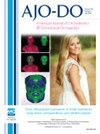Efficacy of planned root torque changes of instanding maxillary lateral incisors with the Invisalign appliance
IF 3
2区 医学
Q1 DENTISTRY, ORAL SURGERY & MEDICINE
American Journal of Orthodontics and Dentofacial Orthopedics
Pub Date : 2025-05-13
DOI:10.1016/j.ajodo.2025.04.016
引用次数: 0
Abstract
Introduction
This study aimed to examine the efficacy of planned root torque changes of instanding maxillary lateral incisors (IMLIs) in patients treated with an initial series of Invisalign aligners (Align Technology, Santa Clara, Calif).
Methods
Pretreatment digital models and digital models representing the planned and achieved treatment outcomes of adult patients prescribed an initial series of Invisalign aligners were measured using Geomagic Control X (version 2017.0.3; 3D systems, Rock Hill, NC). The type of orthodontic tooth movement (OTM) that was planned and achieved was assessed using the center of rotation as a reference point.
Results
A sample of 65 patients with 95 IMLIs satisfied the inclusion criteria. The mean accuracy of the planned root torque change of the IMLIs was 78.9%. Palatal root torque was planned for most (82.1%) IMLIs. The accuracy of root torque expression differed according to whether planned changes were in a palatal or labial direction. Planned palatal torque changes showed a higher level of accuracy. Linear regression analysis indicated that age, sex, presence of an attachment, and type of attachment did not influence the accuracy of root torque expression (P >0.05), whereas planned anteroposterior movement of the IMLI crown did (P <0.01). The most frequently achieved OTM was uncontrolled tipping (54.7%).
Conclusions
The achieved root torque in IMLIs with an initial series of Invisalign differed significantly from that planned. The amount of anteroposterior movement was significantly related to the efficacy in achieving the planned root torque.
Invisalign矫治器计划改变上颌侧切牙根扭的效果。
简介:本研究旨在研究使用Invisalign矫正器(Align Technology, Santa Clara, california)治疗的患者在固定上颌侧切牙(IMLIs)时计划改变牙根扭矩的效果。方法:使用Geomagic Control X(版本2017.0.3;3D系统,Rock Hill, NC)。计划和实现的正畸牙齿移动(OTM)类型以旋转中心为参考点进行评估。结果:65例95例imli患者符合纳入标准。imli计划根转矩变化的平均准确度为78.9%。大多数(82.1%)imli患者计划腭根扭矩。根转矩表达的准确性根据计划的改变是在腭方向还是在唇方向而不同。计划的腭扭矩变化显示出更高的准确性。线性回归分析表明,年龄、性别、附着体的存在和附着体的类型对根扭矩表达的准确性没有影响(P >0.05),而计划的IMLI冠的前后运动则有影响(P结论:使用Invisalign初始系列的IMLI获得的根扭矩与计划的根扭矩有显著差异。前后移动的量与实现计划的根扭矩的有效性显著相关。
本文章由计算机程序翻译,如有差异,请以英文原文为准。
求助全文
约1分钟内获得全文
求助全文
来源期刊
CiteScore
4.80
自引率
13.30%
发文量
432
审稿时长
66 days
期刊介绍:
Published for more than 100 years, the American Journal of Orthodontics and Dentofacial Orthopedics remains the leading orthodontic resource. It is the official publication of the American Association of Orthodontists, its constituent societies, the American Board of Orthodontics, and the College of Diplomates of the American Board of Orthodontics. Each month its readers have access to original peer-reviewed articles that examine all phases of orthodontic treatment. Illustrated throughout, the publication includes tables, color photographs, and statistical data. Coverage includes successful diagnostic procedures, imaging techniques, bracket and archwire materials, extraction and impaction concerns, orthognathic surgery, TMJ disorders, removable appliances, and adult therapy.

 求助内容:
求助内容: 应助结果提醒方式:
应助结果提醒方式:


